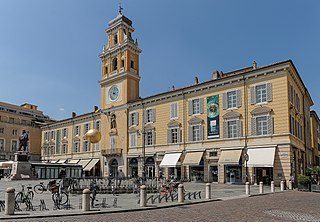
Parma is a city in the northern Italian region of Emilia-Romagna known for its architecture, music, art, prosciutto (ham), cheese and surrounding countryside. With a population of 198,292 inhabitants, Parma is the second most populous city in Emilia-Romagna after Bologna, the region's capital. The city is home to the University of Parma, one of the oldest universities in the world. Parma is divided into two parts by the stream of the same name. The district on the west side of the river is Oltretorrente. Parma's Etruscan name was adapted by Romans to describe the round shield called Parma.

Piacenza is a city and comune (municipality) in the Emilia-Romagna region of Northern Italy, and the capital of the eponymous province. As of 2022, Piacenza is the ninth largest city in the region by population, with more than 102,000 inhabitants.

The Duchy of Parma and Piacenza was an Italian state created in 1545 and located in northern Italy, in the current region of Emilia-Romagna.

Ranuccio I Farnese reigned as Duke of Parma, Piacenza and Castro from 1592. A firm believer in absolute monarchy, Ranuccio, in 1594, centralised the administration of Parma and Piacenza, thus rescinding the nobles' hitherto vast prerogative.

The House of Farnese was an influential family in Renaissance Italy. The titles of Duke of Parma and Piacenza, Duke of Latera and Duke of Castro were held by various members of the family.

Francesco Mochi was an Italian early-Baroque sculptor active mostly in Rome, Piacenza and Orvieto. His dramatic early works in Orvieto are now often regarded as the first truly Baroque sculptures.

Palazzo Farnese is a palace in Piacenza, northern Italy.

The Sanvitale conspiracy was a plot to assassinate Ranuccio I Farnese, Duke of Parma and Piacenza, and members of his family at the baptism of his new-born son Alessandro in 1611. The conspiracy may also be referred to in Italian as the congiura dei feudatari, "conspiracy of the feudal lords", or as the congiura del 1611, "conspiracy of 1611".

San Francesco is a Roman Catholic church, located on Piazza Cavalli #68 in Piacenza, Italy. It was built in a style described as Lombard Gothic and is centrally located facing towards the Piazza del Cavalli, which is surrounded by the Palazzo Gotico and the Palazzo del Governatore.
San Pietro is a Roman Catholic church in central Piacenza, Emilia Romagna, Italy. The church was built over the site of an ancient church titled San Pietro in Foro.

The Palazzo della Prefettura also called the Palazzo Scotti di Vigoleno is a Baroque architecture-style palace located on Via San Giovanni #17 in central Piacenza, region of Emilia-Romagna in Italy. The palace houses the offices of the provincial administration.

Palazzo Comunale is a Gothic style palace located facing Piazza del Cavalli in the historic center of Piacenza, northern Italy which now serves as the seat of municipal administration. The facade is flanked by two bronze equestrian statues sculpted by Francesco Mochi and depicting the Farnese Dukes of Parma: Ranuccio (1612–20) and his father, Alexander (1620-1629). Across the piazza is the late-Baroque or early neoclassic Palazzo del Governatore (1787) designed by Lotario Tomba. Recessed and to the right is the 17th-century Collegio dei Mercanti.
The following is a timeline of the history of the city of Piacenza in the Emilia-Romagna region of Italy.

The Palazzo del Giardino or Palazzo Ducale del Giardino is a historic palace in the Parco Ducale in Parma. It is not to be confused with the official Parma residence of Marie Louise, Duchess of Parma between Palazzo della Pilotta and Palazzo della Provincia in what is now known as piazzale della Pace - she also lived at the Ducal Palace of Colorno and in the Casino dei Boschi in Sala Baganza. The main Ducal Palace in Parma, the Palazzo della Pilotta and the Reinach Theater were all destroyed in an early morning air raid on 13 May 1944, carried out by the 465th Heavy Bombardment Group of the US Airforce, 781st Squadron, which dropped 9 GP bombs on the city centre.

The Ducal Palace of Parma was a neoclassical palace in Parma, Italy. It was located on the west side of the Piazzale della Pace. Between its construction and 1859, it was the residence of the Dukes of Parma. After 1859, it became the prefecture.

Palazzo del Governatore is a neoclassic-style palace located facing Piazza dei Cavalli in the historic center of Piacenza, northern Italy which now houses the town's chamber of commerce. The facade is flanked by two bronze equestrian statues sculpted by Francesco Mochi and depicting the Farnese Dukes of Parma: Ranuccio (1612–20) and his father, Alexander (1620-1629). Across the piazza is the Gothic-style Palazzo Comunale and the two equestrian statues of Farnese dukes, Alessandro and Ranuccio.

The Palazzo del Collegio dei Mercanti is a baroque-style palace located recessed and to the left of the Palazzo Gotico facing Piazza dei Cavalli in the historic center of Piacenza, northern Italy. It now houses the offices of the town hall and council.

San Vincenzo is a Baroque style, Roman Catholic church, now deconsecrated, located at Via Scalabrini #6 in the South-East quadrant of Piacenza, Region of Emilia Romagna, Italy. The church was restored starting in 2009 for use as an auditorium and to host concerts.
















